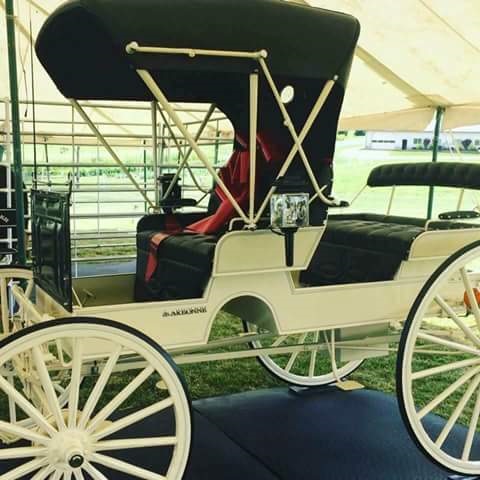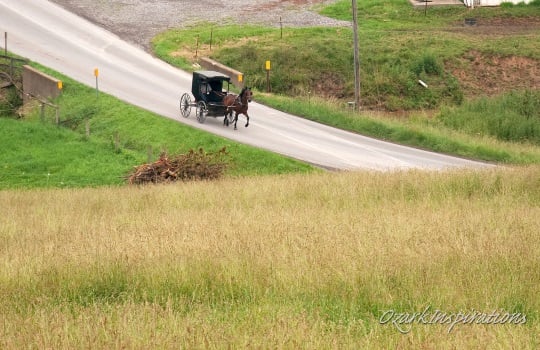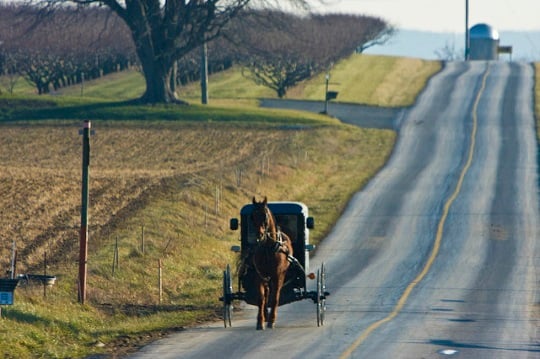Amish & Social Media: Youth Now On Instagram; Women Using It For Business
Lancaster Online recently published a series of articles on the Amish and social media use.
Eight years ago this topic got attention when it was publicized in another Lancaster Online report that Amish youth were using Facebook. We also saw Facebook covered in books like Growing Up Amish: The Rumspringa Years.
Yet time passes and things change, especially in the fast-moving world of social connectivity applications.
Facebook has become passé for many young people in general, replaced by other networks including Instagram and Snapchat. Amish youth have followed this trend, and are on these platforms now:
Like “English” teens, Amish youth have mostly abandoned Facebook, Jantzi said — Instagram is now the most popular social media platform among Amish young adults. (Twitter, which was also popular with Amish teens in the mid-2010s, is seldom used by Amish teens anymore, Jantzi said.)
For many Amish young adults, their follower count on Instagram, which is owned by Facebook and used for photos and video-sharing, almost triples their amount of “friends” on Facebook.
How many Amish (youth or otherwise) use social media? To figure that out, you have to look for clues:
It’s impossible to know how many Amish youth are using social media sites. The young adults seldom identify themselves as Amish, but they expose their upbringing in other ways.
The telltale signs? Traditional Amish dress, “friends” and “followers,” and a traditional Amish name like Stoltzfus, Zook or Glick, according to Charles Jantzi, professor of psychology at Messiah College and researcher of Amish youth and social media.
And what are they posting?
The content on Instagram doesn’t differ too much from what Amish teens were posting on Facebook years ago. On a typical young Amish adult’s Instagram account, one can see selfies, and photos of trips to the beach, friends, and products of trade, such as freshly planted fields or beautifully stained cabinets.
More unique posts include videos of Amish boys mastering skateboarding tricks, shirtless mirror pictures, and selfies taken with vapes in hand.
Captions are often positive and encourage followers to pursue a life with values reflected in the Amish church. More often than not, captions include Bible verses.
Jantzi makes the point that these platforms contrast sharply with Amish mores:
“(Instagram) really places a great deal of emphasis on the person,” he said. “…and that’s so different than Amish tradition.”
Social media sites like Instagram, by default, is focused not on community, but instead of the individual, Jantzi said. As a faith group that focuses on community and condemns individuality, the Amish could be threatened by social media, Jantzi said.
“It’s hard for me to imagine that (Instagram) is not chipping away at some of those internal values that the Amish hold,” Jantzi said.
On the other hand, this also brings to mind a point that Steven Nolt made in the 2011 article about Facebook usage: that since Amish were mainly “friends” with other Amish on the platform, it could have a sort of insulating effect, rather than extending Amish youth’s reach into non-Amish circles.
Amish Women & Social Media
Amish women, it’s reported in a second article, are also using social media – and are finding it a way to enhance their businesses (typically multi-level marketing):
But now, as social media infiltrates the tight-knit community, many younger Plain women, including Amish women, are seemingly using their Instagram accounts to promote their products.
Instead of selling kitchen utensils and food storage containers, many are opting to sell dietary supplements (including hunger suppressants), vegan makeup products and skincare supplements from multi-level marketing companies such as Arbonne and Plexus.
LNP worked with Amish young adults and scholars to confirm the Amish and Plain identities of consultants located in the area.
The product consultants (or ambassadors, depending on the company) in Lancaster promote a picturesque life on their Instagram accounts — photos of trips across the country, picking fresh strawberries from the garden, wearing on-trend “English” clothing — and, of course, whatever products they’re selling.
There are some questions here: combining “Plain” and “Amish” into the description makes it unclear how many of each might be represented (there are some Anabaptist churches which could be described as Plain, but which are more technology-friendly).
It’s also unclear if these are baptized and/or married Amish women, two mileposts which tend to affect what’s considered acceptable behavior. The article uses the description “younger Plain women.”
That noted, another, frankly surprising example is given of an Amish woman who received a customized, downright fancy buggy as a reward for her multi-level marketing success:
For example, Martha Yoder, an Amish woman in Holmes County, Ohio, works as a regional vice president for Arbonne, according to her Facebook page.
Arbonne is a multi-level marketing company that sells skincare products and health supplements. The company, which relies heavily on its “consultants'” ability to recruit other saleswomen, rewards its highest earning and recruiting members by giving them monthly $800 payments for a lease to a Mercedes Benz, according to the company’s site.
But Yoder, who isn’t allowed to drive, designed — with the permission of Arbonne — her own custom, Arbonne-emblazoned buggy, according to several Facebook posts made in August 2017.
I would call Yoder an outlier here just based on the appearance of the buggy:

I doubt that she is driving this to church on Sundays. But maybe it makes for a fun occasional spin.
The usual caveats apply here: this is more likely going to be seen in the more progressive communities. These articles are based on research done in Lancaster County and Holmes County, in a number of ways two of the most progressive communities. I don’t expect to ever find many Swartzentruber Amish basket makers hawking their latest creations to a flock of “Insta-followers.”
The business strategy of the majority of Amish women – whether they are running sewing businesses, market stands, or variety shops – is just not going to hinge on Facebook, Instagram, or anything like that.
Those who do use those platforms are generally outliers, younger and unbaptized/unmarried, or in specific industries in more progressive communities. You’re not going to find a lot of married, church-member Amish women plugging products and expanding networks on Instagram.
But some will use it, either directly or indirectly (meaning, with an outside hand involved).
That goes for Amish businesses in general. To cite a fresh example: the owner of the Virginia bulk food store recently featured here mentioned his Facebook page; however it was handled by an outside person, which is probably going to be the more common approach.
Another good example would be vendors in Pennsylvania Dutch markets, whose businesses are apt to be promoted along with the market as a whole via social media.
Social media is hard to stop
Social media is not taking over Amish life, as it has English life. Yet it’s difficult to completely avoid, even if your home has no electricity and your primary “wheels” have hooves.
Amish have often expressed concern over the infiltration of technology, seeing smartphones in particular as a danger categorically different from other past potentially socially-destructive innovations.
As with other innovations and outside cultural trends, business is a gateway for social media to enter the community – despite those concerns.
While some are leveraging social media to expand their business and social connections, I don’t expect we’ll get to the point where Amish churches are using Facebook groups to share information about upcoming events.
However, even 10 or 15 years ago, it would have been difficult to imagine Amish business people carrying around high-powered smartphones in their pockets…so I’m just going to close with, “never say never.”







Hard to Imagine
Amish on smartphones? I don’t think that’s a good idea to preserve their lifestyle.
A lot of them would agree.
We do indeed agree!!
Social media
I’ve seen some of these Amish facebook/social media accounts and it makes me a little sad.
It shows how englisch life can mix in and alter Amish culture.
I thought Amish were to value family and community. Social media like Facebook and Twitter values the individual, vanity.
I’ve seen the selfies, the look at me on vacation, look at the new girlfriend/boyfriend.
It just doesn’t seem right. The self-promotion. Even when positive bible quotes are posted, it still seems wrong. Cheap. Disingenuous. All to get a thumbs up like from Facebook friends?
Plus, this technology can change Amish behavior. I see Amish women stand in front of a guy they like and pull out their cell phone. It’s a signal for the guy to make a move. She’s interested. And I’m like, he’s standing right in front of you. just walk 5 feet and say hello.
This technology also allows for them to text/communicate in private and secrecy. Behind the parents back. As well as Behind their girlfriend/boyfriends back. Times have changed.
Some of it might be the same phase that many youth go through before becoming older and wiser…though amplified by the smartphone/social media dynamic.
I have never heard of the pull-out-the-phone move as code meaning interest…is this something you’ve noticed just within the Amish or is this a thing among certain youth in general?
Social media
I stumbled on this when at an Amish store and have seen a few Amish women do this. I noticed because an Amish woman with a cell phone stands out more than englisch with one.
I don’t know if this is common for today’s youth or an Amish thing.
Well said!
Unfortunately...
Its hard for me to see Amish groups surviving the use of the smartphone. Literally the entire English world is right there in the palm of your hand.
I get Holmes County and Lancaster Amish may not be representative of all Amish. But they are two of the largest groups.
Hasidic Jews don’t allow smartphones or the internet. I think theirs is the much wiser approach.
Some of us have very serious concerns about the effect the Smartphone has on our youth! Sadly, not JUST the youth.
I’m going to respectfully challenge the Hasidic Jew statement, though. There are different groups of Hasidm, right? I had a few conversations with several Hasidic men over the last two years. Several backed up what you said, but two showed me they had Smartphones. I wish I could remember which group was called which name! It was interesting to me the ones who had Smartphones talked about noticing the same changes we see.
I use a computer & the internet at work & the library, but both are monitored. At work our internet is strictly filtered, at the library I usually have other people — often Amish — sitting right beside me. But still, even so I see how it changes the way we think and how we conduct business or what we expose ourselves to.
Well, you know more Hasidic Jews than I do, and I was getting my information about them from articles online and a few documentaries. So if you say some have smartphones, I’ll defer to your experience.
It’s just odd to me about the Amish; they keep regular phones outside the house in the form of public booths, but allow smartphones, which seem SO much more dangerous? I get that they can use them for business, but how were they running businesses before? I wonder if groups will split over this.
On a more positive note, it looks like the Amish are starting another settlement in Maine.
https://www.centralmaine.com/2019/09/27/maines-amish-community-expands-into-wales-plans-to-renew-farm-lifestyle/
I had read the same thing, which was why I was surprised to discover at least one group did allow them. Again, I am aware that there are several different branches of Hasidic Jews, though I don’t know enough about it to know which group is which. I guess I was doing with them like so many people do with the Amish — assuming they were all the same. 🙂
In our group, the Smartphone is NOT allowed. I’d say the majority of Amish districts in our large community have not allowed it, but some have either just gone ahead and gotten them anyhow or use ones that have supposedly been “customized” for Amish use. I feel I should point out that many Amish smartphone users are unbaptized youth. Because they are not yet baptized, they are not bound by the same standards as members. So you might have parents being members in a church that does not allow the smartphone while they have kids who do own them. In my lifetime I have seen very few “things” that have caused so much struggle in Amish churches.
So...
Your district disallows the smartphone but allows some measure of computer/internet use? That’s interesting. Can I ask what your large community is? Holmes County?
It’s nice to think that a lot of these kids will put their smartphones away for good upon being baptized. It’s probably not unreasonable either. I’m English and I have an ambivalent relationship with mine. 🙂 But I wonder what a smartphone “customized” for Amish use looks like. I don’t know of any effective way to screen out all the unwholesome elements of the internet from any given phone’s access, but maybe they exist. If I were a parent I would certainly be looking for one.
Yes, I am in Holmes Co. and the Smartphone is not allowed in our group, but computer access either through work or at a library is allowed.
I have to admit I am not 100% sure what the customized Smartphones are, having never used or bought one. I see them advertised in publications like The Plain Communities Business Exchange, which might advertise a phone that is “talk and text only” or the like. They are typically advertised by Mennonite businesses, such as “Golden rule” communications or the like. But again, the only think I know about them is seeing the advertisements. I’ve seen them in use and to me they look just like a Smartphone, but presumably they have certain features disabled?
It might be like the word-processors sold to the Amish that might run Excel & Microsoft word programs, but not allow any internet access. I have one of those at home.
Parents Responsibility !!!
If smart phones are starting to be used by teens in a community that bans them, then some of the parents are not acting responsibly.
My children DO NOT use smart phones or the internet. Many non amish families also do not allow their children to have smart phones. And you better believe the parents would certainly know if their children had one or not. Those phones are not cheap. If they have one, the parents are looking the other way and not taking the steps to prevent it. Also they are failing to curtail their children’s interactions with non amish or those of questionable character. Those parents need to be strongly spoken to by the other brothers in the church. And those who are allowing their children to have smart phones should be shunned in my opinion.
The damage to the social structure of society by the use of cell phones has become very apparent. It has destroyed almost all moral restraints in the non amish world, and I would hate to see it happen to the the Amish.
Moral restraints
“It has destroyed almost all moral restraints in the non amish world” Wow! Your comment sounds extreme yet rings very true. Unlimited access to social media like dating websites and pornographic media seems to foster indiscretion and makes social restraint seem old fashioned. And that’s among the English. Amish tolerance of social media seems very insidious compared to other modern technology against which they strictly resist. Motor vehicles are primitive technology compared to smart phones and the internet. While one is relatively more tolerated the other remains utterly forbidden.
Yes, VERY questionable character, including the very worst! The Amish must not be aware also that these devices are used to constantly monitor us, then influence us in ways that amazing and scary. It’s a whole science and very advanced. They say it’s for advertising but I believe it’s for more than that; some people are calling them grooming devices. If they only knew, they would shun them.
I didn’t allow my children to have them until they were almost out of high school and about to get them on their own. I didn’t buy them and probably wouldn’t have, but saw it as an opportunity to help prepare and train them to make wiser choices with them . Never before have I ever seen any object treated more like an idol by so many!
I have to agree to your idol comment… it’s scary how many people can not live without it, even for a moment. They sleep with it, spend their whole day with it, stare at it instead of talking to their spouse, children or friends. It has a fascination power well above that of the television or even internet on a computer. It feels like it will be impossible to go back, and I am worried that it will change people irrevocably – to say nothing of the intense surveillance and constant advertising we’re subjected to.
To be honest it would probably be wise for Amish communities to use only ‘dumb phones’ for business or emergency purposes, and to ban smartphones altogether. I wish it was so in the English world.
Also of note:
I noticed that some Amish youth have 2 social media accounts. One seems to be more Amish, or clean. The other is more ‘englisch.’ They wear regular clothes, show off drinking games, cars, and so on.
It is always odd for me to see Amish youth be soft spoken and act kind during the day, then see them update their social media account with pictures that are…not modest.
It’s like they are 2 different people.
This exposure to social media has no doubt changed the Amish. When they get baptized and join the church, they don’t leave behind or forget their past. It stays with them. And affects how they raise the next generation.
Social media? Really?
How can the Amish deny themselves modern things IE technology and let their children use social media? This seems hypocritical and much worse than simple electricity! I admire the Amish lifestyle and HATE social media this disappoints me. Social media is horrible – and nothing good comes from it if you consider the pros and cons.